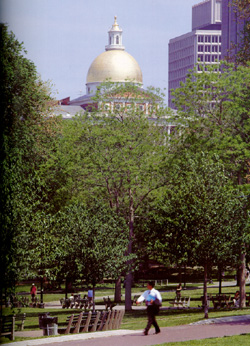Boston Common

The Boston Common, established in 1634, is the oldest public
park in the United States. It is the most famous of the New England
"commons," or common lands, around which New England towns were organized.
It began as a pasture where colonists could keep their cattle, a practice
which continued until 1830. It has retained its character as a much
needed green space in the heart of the city. No building of any significance
has ever stood on it. Historian Henry Adams, who grew up on Beacon
Hill around the time of Robert Shaw, remembers having large snow fights
on the Common as a boy. Shaw marched past the Common with the 54th
Massachusetts regiment on their way to war. Lore has it some cheered
them and some, watching from their mansions on Beacon Street, pulled down
their shades as a sign of protest. The dedication of the Shaw memorial
in 1897 of course took place on the Common. The memorial is at the
edge of the Common facing Beacon Street and the State House. Lowell
himself lived near the Common as a young man in the 1940s.
The Oxford English Dictionary (OED)dates this use of "common"
back to 1479 and defines it as: "A common land; the undivided land
belonging to the members of a local community as a whole. Often pluralized
as "commons.'" The word even in Lowell's usage carries the
wider associations of:: ordinary, general, and community.
How might the meaning and history of the "Boston Common" be working
in Lowell's poem?
Back to Poem
|
